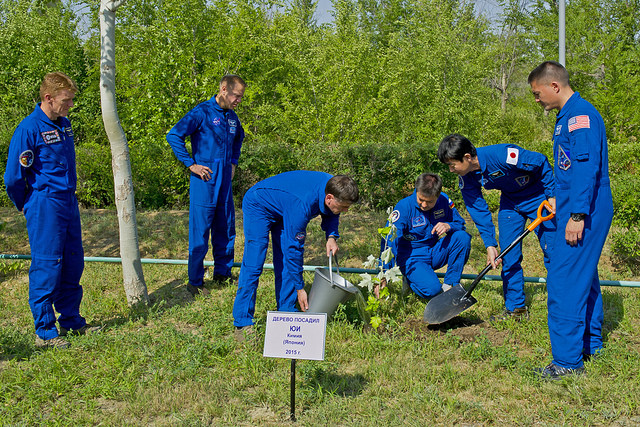
Three new spacefarers will rocket toward the International Space Station (ISS) tomorrow (Wednesday, 22 July), destined to spend about five months conducting research, maintenance, and reconfiguration of the U.S. Orbital Segment (USOS) of the multi-national orbiting outpost. As described in yesterday’s AmericaSpace article, veteran Russian cosmonaut Oleg Kononenko and “rookies” Kjell Lindgren of NASA and Kimiya Yui of the Japan Aerospace Exploration Agency (JAXA) will launch from Site 1/5 at the Baikonur Cosmodrome in Kazakhstan, aboard Soyuz TMA-17M, at 3:02 a.m. local time Thursday (5:02 p.m. EDT Wednesday). In keeping with several previous ISS crews, they will follow a six-hour, four-orbit “fast rendezvous” profile to reach the space station and dock with its Earth-facing (or “nadir”) Rassvet module at about 8:43 a.m. Baikonur time Thursday (10:43 p.m. EDT Wednesday). Current plans call for Kononenko, Lindgren, and Yui to join the incumbent Expedition 44 crew of record-setting Commander Gennadi Padalka and One-Year crewmen Mikhail Kornienko and Scott Kelly, all of whom have been in orbit since March.
Yesterday (Monday), the mammoth Soyuz-FG booster—a direct descendent of the R-7 Intercontinental Ballistic Missile (ICBM), conceived in the 1950s by the legendary Chief Designer, Sergei Korolev—was transferred horizontally by rail to Site 1/5 at Baikonur, much to the excitement of Kjell Lindgren’s 7-year-old son. “THAT’S OUR ROCKET!” Lindgren tweeted, adding capitalization for understandable impact, to which recently returned Expedition 43 Commander Terry Virts responded: “The only thing better than launch, Kjell, is re-entry!” Earlier, inside the Spacecraft Assembly and Testing Facility at Baikonur, Lindgren posed with Kononenko and Yui at the foot of their horizontal booster. “The business end of our rocket,” he tweeted on Sunday. “Hard to fully comprehend the power this thing will produce to get us into orbit.”
Positioned in the center seat aboard Soyuz TMA-17M for tomorrow’s launch is Oleg Dmitriyevich Kononenko, a veteran of two previous ISS expeditions—including command of Expedition 31 from April-June 2012—and holder of a cumulative 391 days, 11 hours, and 18 minutes in space, which currently positions him as the 19th most seasoned spacefarer in history. By the time Kononenko returns to Earth on 22 December, he will have amassed over 544 days in orbit, thereby pushing himself up the experience list into 11th place.
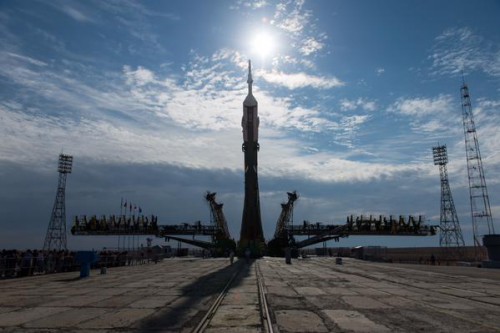
In the present ISS era, each Soyuz typically carries just one or two Russian cosmonauts, with the remaining seats occupied invariably by a U.S. astronaut and, twice annually, by a representative of one of the International Partners (IPs), whether the European Space Agency (ESA), the Italian Space Agency (ASI), the Canadian Space Agency (CSA), or JAXA. This has created an operational climate in which civilian cosmonauts are commanding Soyuz missions more frequently, a situation quite different from the earlier Salyut and Mir eras, when military commanders were almost invariably paired with civilian flight engineers. In fact, since Expedition 1 got underway in the fall of 2000, no fewer than 13 of the 42 ISS-bound Soyuz spacecraft—about 30 percent—have been commanded by civilian cosmonauts. This contrasts sharply with the Soviet Union’s Salyut era from 1971-1986, which saw just two civilian commanders in 40 station-bound Soyuz missions, and the Mir era from 1986-2000, which saw no civilian commanders in 30 launches.
Born on 21 June 1964 in Chardzhou—today’s Türkmenabat—on the banks of the Amu Darya River and close to Turkmenistan’s border with Uzbekistan, Kononenko grew up in a city whose position on the Silk Road made it culturally important and whose history extends back almost two millennia. “I am a person who does not analyze the past,” Kononenko said in a recent interview. “I live in the present and a little bit in the future. However, I sometimes go back in time and analyze the steps and actions I took, and I realize that the vector was always pointed towards space.”
It was a vector which was guided by his parents. As a boy, Kononenko yearned to design and fly his own space vehicle, although he very quickly encountered a crossroads: he could either become an engineer and designer, like his hero, Sergei Korolev, or become a cosmonaut. He chose the latter. “I could not imagine myself having another job,” he said in the weeks preceding his second mission, in the fall of 2011. “Maybe it’s different for some other people, but I always wanted to be a cosmonaut and I did not believe there is a better job … on Earth.” His parents encouraged him to do well in his education and took him to model rocketry clubs, but Kononenko soon noticed that virtually all of the early cosmonauts were military pilots. And therein lay another obstacle. “Since I read a lot and I was performing modeling … my eyesight was worsening,” he said, “and that was a tragedy, because I realized I was going to have problems entering a pilot school.”
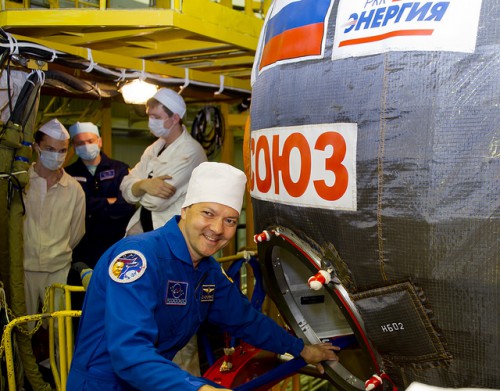
A supportive math teacher then told him that civilians could also fly into space, and Kononenko entered the N.E. Zhukovsky Kharkov Aviation Institute, within today’s Ukraine, graduating in 1988 as a mechanical engineer. He then worked as an engineer, design engineer, and leading design engineer for the Central Design Bureau in the south-eastern Russian city of Samara, before being selected as a test-cosmonaut candidate in early 1996. After two years of initial training, he qualified as a test-cosmonaut in March 1998 and commenced preparations for a future ISS expedition. In December 2001, he and fellow cosmonaut Gennadi Padalka—currently in orbit as Commander of Expedition 44—were named as the backup crew for the Soyuz TM-34 “taxi” mission, a 10-day voyage which took place in April-May 2002 and served to exchange Soyuz vehicles at the station.
Prior to the Columbia disaster, Kononenko was assigned with Padalka and U.S. astronaut Mike Fincke as the prime crew for Expedition 9, originally scheduled to take place between January-July 2004. Their names were formally announced in March 2002, and they would have launched aboard shuttle mission STS-119, but in the aftermath of Columbia and a reduction of ISS crews from three to two members, Kononenko found himself removed from the roster. He continued his generic training and in March 2006 began preparations with fellow cosmonaut Sergei Volkov for Expedition 17, to which he was officially assigned in February 2007. Launched aboard Soyuz TMA-12 on 8 April 2008, the pair were accompanied for the journey uphill by South Korea’s Soyeon Yi—the latter of whom flew as a Spaceflight Participant (SFP)—and joined the incumbent Expedition 16 crew of U.S. astronauts Peggy Whitson and Garrett Reisman and Russia’s Yuri Malenchenko. After a brief handover of operations, Whitson, Malenchenko, and Yi returned to Earth aboard their Soyuz TMA-11 spacecraft, leaving Volkov, Kononenko, and Reisman aboard the ISS to continue Expedition 17 through the summer. In doing so, they became the first, and so far only, “all-rookie” crew of the ISS era.
This lack of prior spaceflight experience did not undermine what was a spectacular mission. During their six months aloft, Volkov and Kononenko welcomed two unpiloted Progress resupply freighters and the crew of Shuttle Discovery on STS-124, which delivered the pressurized research module of Japan’s Kibo facility and exchanged Reisman for another U.S. astronaut, Greg Chamitoff. On 10 and 15 July, Volkov and Kononenko performed a pair of EVAs, totaling 12 hours and 12 minutes, whose tasks included inspecting their Soyuz TMA-12 spacecraft—with specific focus upon problematic pyrotechnic bolts linking the instrument module to the descent module—and removing and installing scientific experiments and installing rendezvous equipment for the long-delayed Nauka Multi-Purpose Module (MLM). Finally, in October 2008, the Soyuz TMA-13 crew of Russian cosmonaut Yuri Lonchakov, U.S. astronaut Mike Fincke, and SFP Richard Garriott arrived to begin a week of changeover operations. On the 23rd, Volkov, Kononenko, and Garriott boarded Soyuz TMA-12 and returned to Earth. Kononenko’s first space mission was over after 198 days, 16 hours, and 20 minutes and over 3,100 orbits of Earth.
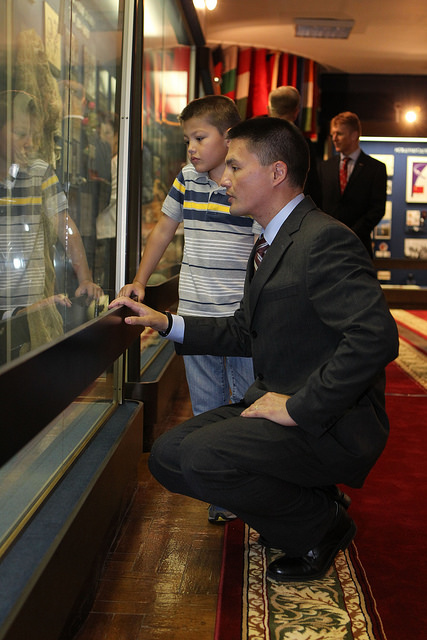
By his own admission, Kononenko’s second mission, to which he was formally assigned in October 2009, would be quite distinct from his first, for three reasons. Firstly, his crew would form part of the newly expanded ISS, which had by now moved into six-person operations. Secondly, “his crew” was an appropriate descriptor, because—joined by U.S. astronaut Don Pettit and Dutchman Andre Kuipers, flying on behalf of ESA—he would be in command of the Soyuz TMA-03M spacecraft for launch, ascent, rendezvous, docking, undocking, and return to Earth. And finally, with the return of the Expedition 30 crew of U.S. astronaut Dan Burbank and Russian cosmonauts Anton Shkaplerov and Anatoli Ivanishin in April 2012, Kononenko would take command of the ISS to lead Expedition 31 through the end of June.
Launched on 21 December 2011, Kononenko, Pettit, and Kuipers successfully reached the ISS about two days later, joining the incumbent Expedition 30 crew and kicking off what was expected to be a five-month expedition aboard the space station. However, delays to the launch of the following Soyuz TMA-04M crew from March until May 2012 obliged NASA and its partners to extend the landing of Kononenko, Pettit, and Kuipers from mid-May until 1 July, producing a total duration of 192 days, 18 hours, and 58 minutes, and a little over 3,000 orbits of the Home Planet. During their long stay, Kononenko and Shkaplerov performed an EVA lasting six hours and 15 minutes on 16 February 2012, during which they relocated the Strela (“Arrow”) crane, jettisoned a Multi-Layer Insultion (MLI) cover, and installed and removed scientific samples. With the return of Burbank, Shkaplerov, and Ivanishin to Earth on 27 April, Kononenko took command of the ISS, and Expedition 31 was later expanded back to six members with the arrival of Soyuz TMA-04M crewmen Gennadi Padalka, Sergei Revin, and Joe Acaba. During their final weeks in orbit, Kononenko’s crew welcomed the first privately funded cargo ship ever to berth at the ISS—the first SpaceX Dragon, flying its Commercial Orbital Transportation Services (COTS) “demo” mission—and supported numerous scientific investigations aboard the orbital outpost.
Landing on 1 July, Kononenko had accrued 391 days, 11 hours, and 18 minutes across his two missions, thereby positioning himself as the world’s 16th most experienced spacefarer. Since then, his place on the records table has slipped slightly, with fellow cosmonauts Pavel Vinogradov, Fyodor Yurchikhin, and Oleg Kotov edging him down to 19th place, although Kononenko is expected to move back up to 11th place by the time he returns to Earth aboard Soyuz TMA-17M on 22 December.
Seated to Kononenko’s left side aboard the spacecraft tomorrow, in the “Flight Engineer-1” position, will be Kimiya Yui, who becomes the 10th Japanese spacefarer and the fifth of his countrymen to embark on a long-duration mission. Since the commercial voyage of Tokyo Broadcasting System (TBS) journalist Toyohiro Akiyama to the Mir space station in December 1990, Japan has carved an impressive niche for itself in the annals of space exploration. The first “professional” Japanese astronaut, Mamoru Mohri, flew aboard the Spacelab-J shuttle mission in September 1992, followed by Japan’s first woman in space, Chiaki Mukai, aboard STS-65 in July 1994, Japan’s first spacewalker, Takao Doi, aboard STS-87 in the fall of 1997, and Japan’s first long-duration space station occupant—and, subsequently, the island nation’s first ISS Commander—Koichi Wakata, who flew a pair of lengthy missions in 2009 and 2013-2014. Others have participated in a number of key shuttle and station missions. Takao Doi, Soichi Noguchi, and Koichi Wakata were aboard the ISS for the installation of its three major Japanese elements in 2008-2009, whilst Naoko Yamazaki was the last Japanese ever to fly aboard the shuttle in April 2010.
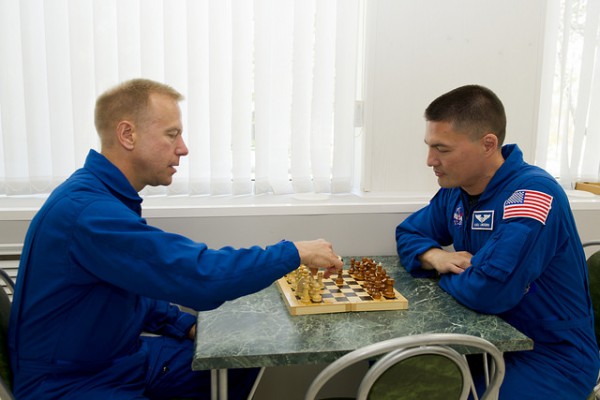
Making his first spaceflight, Yui—a former Lieutenant-Colonel in the Japan Air Self-Defense Force (JASDF) and the first Japanese military man ever to travel beyond Earth—will spend exactly five months away from the Home Planet during Expeditions 44 and 45. Born in the lettuce-growing village of Kawakami, in Japan’s Nagano Prefecture, on 30 January 1970, Yui graduated from the National Defense Academy in 1992, receiving education and training before enrolling in the Air Self-Defense Force as an officer. During his military career, he flew the F-15 Eagle and worked in the Air Staff Office’s Defense Planning Division, before being selected by JAXA in early 2009. Due to the policy of Japan to separate military and scientific fields, Yui was required to retire from the JASDF in order to undertake astronaut training. He completed his initial training, alongside NASA’s Group 20 astronauts and Canadian and European candidates, in the summer of 2011.
He was subsequently assigned with NASA astronaut Dottie Metcalf-Lindenburger, Cornell University planetary scientist Steve Squyres, and British ESA astronaut Tim Peake to participate in the NASA Extreme Environment Mission Operations (NEEMO)-16 undersea expedition in June 2012. During their 12 days situated 63 feet (19 meters) below the surface of the Atlantic Ocean, off the coast of Key Largo, Fla., the crew worked to test innovative solutions to engineering challenges, allowing astronauts to eventually explore asteroids. It is fitting that Yui and Peake will also work together in an equally challenging environment in 2015, for they will both be aboard the ISS at the same time for a few days in December.
Yui was assigned to the Expedition 44/45 crew in October 2012. Originally scheduled to fly from 26/27 May through 5 November, recent delays to the ISS manifest—triggered by the April failure of Progress M-27M and subsequent booster inspections—mean that their launch and landing have been correspondingly pushed back. Current plans call for the Soyuz TMA-17M crew to return to Earth on 22 December, which means that Yui will be in orbit on 2 December, marking the 25th anniversary of Akiyama becoming Japan’s first citizen in space. And when Yui returns to Earth, after about 153 days in orbit, he will automatically become the fourth most experienced Japanese astronaut to date.
Also aboard the Soyuz TMA-17M spacecraft, seated to the right side of the cabin in the “Flight Engineer-2” position, is Dr. Kjell Norwood Lindgren, who becomes the third member of NASA’s Group 20 astronaut intake—selected in June 2009—to draw a flight assignment and reach space. Born on 23 January 1973 in Taipei, the capital of Taiwan, Lindgren spent much of his childhood in England and also lived in the Midwest of the United States. He earned a degree in biology, with a minor in Mandarin Chinese, from the U.S. Air Force Academy in 1995, during which time he was also a member of the “Wings of Blue” parachuting team and served as an instructor, jumpmaster, and part of the intercollegiate national championship team.
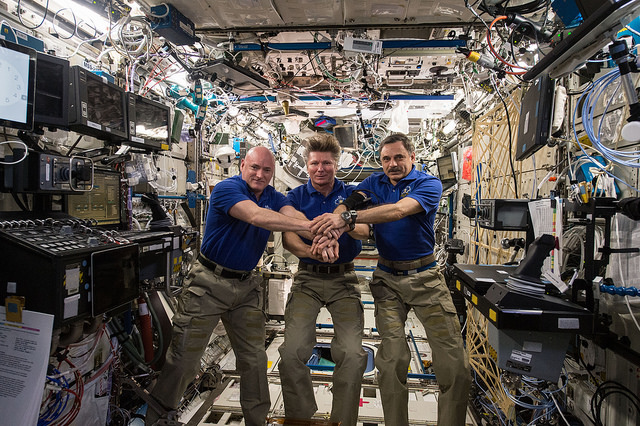
Lindgren then gained a master’s credential in cardiovascular physiology from Colorado State University in 1996—conducting cardiovascular countermeasures research in the Space Physiology Laboratory at NASA’s Ames Research Center in Sunnyvale, Calif.—and received his medical doctorate from the University of Colorado in 2002. He completed a three-year residency in emergency medicine, including a chief resident year at Hennepin County Medical Center in Minneapolis, Minn., followed by a National Library of Medicine Post-Doctoral Fellowship and Master of Health Informatics at the University of Minnesota in 2006. Lindgren subsequently undertook a two-year residency in aerospace medicine in 2008 and gained a Master of Public Health (MPH) degree in 2007 at the University of Texas Medical Branch in Galveston, Texas.
In 2007, he arrived at NASA’s Johnson Space Center (JSC) in Houston, Texas,as a Wyle-University of Texas Medical Branch flight surgeon, supporting ISS operations at the cosmonauts’ training center at Star City, on the forested outskirts of Moscow, as well as water survival exercises in Ukraine. Lindgren eventually rose to become Deputy Crew Surgeon for STS-130—the second-to-last voyage of Shuttle Endeavour—and Expedition 24, when he tendered his astronaut application, along with over 3,500 others, and was subsequently summoned for interview and later selected by NASA as a member of the greatest flying fraternity in the world. “I think I had a versatile background with emergency medicine and military experience in an operational setting,” Lindgren told an interviewer from the University of Colorado Medical School. “I was used to decision-making under high pressure, in a team environment.” Following two years of training and evaluation, Lindgren was assigned with Kononenko and Yui to the Expedition 44/45 crew in July 2013.
Interestingly, with the changes to the ISS manifest in the second half of the year, Kononenko, Lindgren, and Yui should set themselves up for some interesting situations, with regard to their fellow crewmates. During his five months aloft, Kononenko will spend time in orbit with several comrades from previous missions, both flown and unflown. When he arrives aboard the space station, the incumbent Expedition 44 Commander will be none other than Gennadi Padalka, with whom he initially trained for the original Expedition 9, way back in 2002. He will later be joined by his old Expedition 17 crewmate Sergei Volkov aboard Soyuz TMA-18M in early September and by Yuri Malenchenko—with whom he flew briefly for a handful of days in April 2008—who is due to arrive aboard Soyuz TMA-19M in mid-December. As for Yui, his former NEEMO-16 crewmate, Tim Peake, will arrive at the ISS toward the end of his expedition. And for all three Soyuz TMA-17M crewmen, they will be faced with the rare occurrence of meeting their entire backup crew in orbit, when Malenchenko, Peake, and U.S. astronaut Tim Kopra arrive at the station to kick off their own six-month expedition.
Want to keep up-to-date with all things space? Be sure to “Like” AmericaSpace on Facebook and follow us on Twitter: @AmericaSpace
Missions » ISS » Soyuz TMA-M » TMA-17M »



One Comment
One Ping
Pingback:Soyuz TMA-17M Crew Rockets to Orbit, Bound for Five Months Aboard Space Station – UPDATE « AmericaSpace